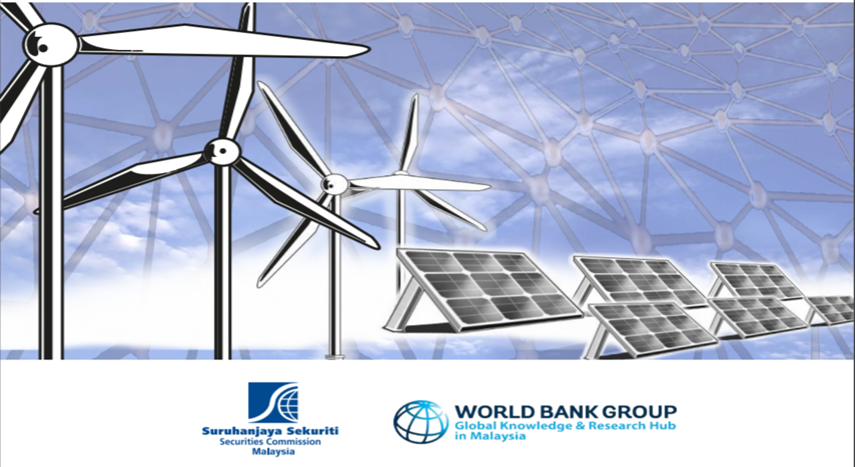
BIX ARTICLE
Islamic Green Finance Development, Ecosystem And Prospects Report By Securities Commission Malaysia (SC) And World Bank Group
Apr 23, 2019
|
7 min read
Featured Posts
SRI Sukuk: The Journey Towards Sustainable and Responsible Investment
Jul 23, 2020
|
5 min read
Securities Commission's Capital Market Masterplan 3 (CMP3)
Sep 21, 2021
|
2 min read
What If We Allowed Retail Investors to Directly Invest in Malaysia’s Government Bond?
Aug 24, 2021
|
8 min read
Islamic Bonds Come Under Microscope After Garuda Indonesia Default
Aug 19, 2021
|
8 min read

Securities Commission Malaysia SC and World Bank Group publish the ISLAMIC GREEN FINANCE DEVELOPMENT, ECOSYSTEM AND PROSPECTS report recently. This report by the Securities Commission Malaysia (SC) and the World Bank Group is based on the presentations and discussions from the Conference organized by the SC, World Bank Group and the IOSCO Asia Pacific Hub on Harnessing Islamic Finance for a Green Future held from 14 to 15 May 2018 in Kuala Lumpur.
The Securities Commission Malaysia – World Bank Group – IOSCO Asia Pacific Hub Conference themed, ‘Harnessing Islamic Finance for a Green Future’, discussed and deliberated on the potential of Islamic finance to support climate mitigation and adaptation efforts, including the use of Islamic finance instruments to finance green activities including renewable energy, natural resources and energy efficiency projects. It explored policy, regulatory and institutional elements required for the sustainable use of Islamic finance to address climate change. Additionally, a set of case studies on the recent use of green sukuk to finance projects in Malaysia and Indonesia, and the possible replication of these instruments in other developing and emerging markets were presented at the Conference. This report aims at synthesising the essence of the discussions deliberated at the Conference.
Business-as-usual approach no longer works under the current climate change phenomenon. Although it has been a while since the world recognizes the importance of addressing climate change, recent climate-related events have underscored the need for urgent action. The financial sector has an integral role to play given the scale of the financial resources required to support climate mitigation and adaptation initiatives. Given the strain on government budgets, the mobilization of private sector financing through innovative instruments becomes imperative.
There is a strong nexus between Islamic finance and green finance. The Conference illuminated the actual nexus between Islamic finance and green finance or more generally sustainable finance. A theme that was emphasized throughout was the natural fit between Islamic finance and green finance, in light of its fundamental principles of risk sharing and sustainability, which could prove critical in financing investments to address climate change, often involving innovative activities and technologies.
Islamic finance has witnessed rapid growth and today, the total Shariah-compliant assets is estimated around US$2 trillion. This offers tremendous potential in supporting the climate change agenda. Green economic development cuts across a myriad of economic sectors such as transportion and energy waste. A clear message emanating from the Conference was that the greener the economy, the better the climate change phenomenon is being managed. This entails pursuing balanced economic development programmes which coincides well with the core principles of Islamic finance that builds upon the concept of maqasid al-Shariah.
Innovations in term of structures is important to increase the amount of funding for environmentally beneficial projects. The United Nations Commission on Trade and Development (UNCTAD) has estimated that US$5 trillion to US$7 trillion in annual investments will be needed until 2030 to fund the 17 Sustainable Development Goals (SDGs) in developing countries. There must be a multi-pronged long-term approach to combating climate change and Islamic finance can significantly contribute by providing various financing solutions and tapping on a wider investor base.
Islamic green finance requires a robust ecosystem to grow faster. The green bond market has grown exponentially over the last few years and Islamic finance has the opportunity to leverage this global trend. There is a misconception that green bonds are more complex and costly to issue, and this needs to be corrected. The green bond market is an example of how the conventional capital market has shifted its focus in factoring climate concerns into finance and investments. The Islamic capital market segment follows suit with the issuance of the green sukuk and more recently with the sovereign green sukuk. There is a good number of case studies available on how sukuk has been used to support certified green projects. They highlight key aspects like facilitating factors, challenges faced and solutions provided as well as the experiences in using sukuk.
Standards and guidelines as key building blocks for Islamic green finance. Necessary framework and ecosystem are potentially key drivers in bridging Islamic finance and the green industry. Regulators are seeking a better understanding of key factors that facilitate the capital market ecosystem for sustainable financing. This includes the development of sustainable asset classes such as green bond/ sukuk, funds and indices. The Conference highlighted some of the building blocks that can help pave the way for Islamic green finance. This includes the discussion on standards and guidelines as well as an enabling environment for Islamic green finance, namely, the role of international institutions and regulatory authorities in establishing the required ecosystem.
Developing successful green sukuk programs requires commitment from issuers, investors, policymakers and industry practitioners. Green bond framework emphasizes the use and management of proceeds, reporting process and external party review, which are among the processes involved that require attention by the issuers. At regulatory level, efforts to spur the issuances by means of incentives or policy may be required based on market needs. As for investors, disclosure is among areas of concern which may include investment screening and reporting. Investors of this segment may vary which include, among others, fund managers, public and private pensions, reserve managers, insurance and takaful companies where these investors are all significantly shifting towards green and Sustainable and Responsible Investment (SRI).
Institutional investors as a leading example on the role of the private sector. Many institutional investors are shifting themselves from merely being just an investor to a responsible investor. Globally, pension and sovereign wealth funds are shifting their investment to sustainable investment and this will further attract positive change among portfolio of investment communities. The sovereign wealth funds have also considered the level of climate change exposure in their portfolios. They are adopting Environmental, Social and Governance (ESG) criteria to better manage sustainability risks.
There are already successes to celebrate; there are equally multiple challenges to attend to. The Conference showcased several successful case studies on Islamic green finance which serve as a motivation and encouragement to achieve higher results. These case studies not only reveal the ingredients for success, but also key factors that can constrain or impede success. There is a need to identify elements in the structure or environment that could have derailed these successes. In fact, experience-sharing sessions during the Conference recognized the significance of identifying these critical challenges i.e. leadership, awareness to investors and regulatory frameworks. Appreciating these challenges allow for potential transferability of these success stories to other jurisdictions with different cultures. The green finance market is expanding beyond bonds and Islamic finance which can expand its impact across other asset classes, including positive screening to incorporate ESG into Shariah-compliant equities, sukuk for waqf development and impact investing, social bonds and many more.
In summary, Islamic finance can be a catalyst for growth of green developments globally. Investors in Europe, Americas, Africa and Asia are witnessing the effects of non-sustainable investments on assets and portfolios that are exacerbating the climate change effects. This emerging trend provides greater opportunities for Islamic finance to attract a wider investor base and expand its role to support sustainable objectives of finance. This will require continuous collaboration with all stakeholders to converge in standards and reporting, as well as to spur innovation, reduce barriers and cost for issuers while increasing transparency and awareness for investors
You can find the full report here
Disclaimer
The information provided in this report is of a general nature and has been prepared for information purposes only. It is not intended to constitute research or as advice for any investor. The information in this report is not and should not be construed or considered as an offer, recommendation or solicitation for investments. Investors are advised to make their own independent evaluation of the information contained in this report, consider their own individual investment objectives, financial situation and particular needs and should seek appropriate personalised financial advice from a qualified professional to suit individual circumstances and risk profile.
The information contained in this report is prepared from data believed to be correct and reliable at the time of issuance of this report. While every effort is made to ensure the information is up-to-date and correct, Bond and Sukuk Information Platform Sdn Bhd (“the Company”) does not make any guarantee, representation or warranty, express or implied, as to the adequacy, accuracy, completeness, reliability or fairness of any such information contained in this report and accordingly, neither the Company nor any of its affiliates nor its related persons shall not be liable in any manner whatsoever for any consequences (including but not limited to any direct, indirect or consequential losses, loss of profits and damages) of any reliance thereon or usage thereof.
YOU MAY ALSO LIKE
ARTICLE
Jul 29, 2025
|
3 min read
ARTICLE
Jul 16, 2025
|
5 min read
ARTICLE
May 19, 2025
|
4 min read
ARTICLE
Mar 21, 2025
|
8 min read


